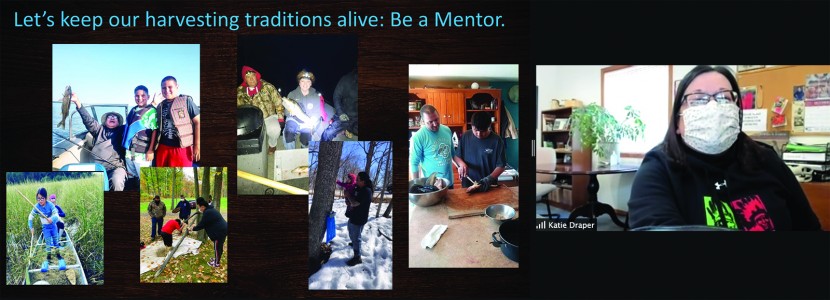
Each year on the Friday closest to March 24, the Mille Lacs Band’s Department of Natural Resources hosts a Treaty Rights Day celebration. In normal years, Band members gather at Grand Casino Mille Lacs (or occasionally the District I Community Center) to celebrate the day in 1999 when the U.S. Supreme Court affirmed Mille Lacs Band members’ right to hunt, fish, and gather under the terms set forth in the Treaty of 1837.
Last year, in the early days of the COVID-19 pandemic, the celebration had to be canceled, but this year, the DNR brought the celebration to Band members’ homes via Zoom — technology with which many have become familiar during the dark days of the last year.
Commissioner of Natural Resources Katie Draper was not about to let the pandemic cancel a special day for a second year, so she and her team prepared a series of fun and educational events for the week — culminating with everyone’s favorite: a raffle, with a variety of great prizes.
“March 24th is a significant day for us as Anishinaabe as we demonstrate our resilience by exercising our treaty rights through hunting, fishing, and gathering,“ Katie said. “Let’s keep our harvesting traditions alive by being mentors to others.“
The 1837 Treaty Case
The Band’s 1837 Treaty Case revolved around a single sentence in the Treaty of 1837: “The privilege of hunting, fishing and gathering the wild rice upon the lands, the rivers and the lands included in the territory ceded, is guaranteed to the Indians during the pleasure of the President of the United States.“ (1837 Treaty, Article 5.) — but it took nearly a decade from the time the case was filed until the U.S. Supreme Court ruled 5–4 in the Band’s favor.
The treaty rights of the Mille Lacs Band had lain dormant for most of the 20th century, but political and legal activism by tribes in the Pacific Northwest and in Minnesota inspired Chief Executive Arthur Gahbow to take action on the Band’s rights.
In 1980, the Band passed a Conservation Code, which pertained to the regulation of hunting, fishing, trapping, and other matters within the 1855 Treaty reservation boundaries. The code was met with immediate opposition, which continued throughout the next two decades.
In 1982, Chairman Gahbow directed his Commissioner of Natural Resources, Don Wedll, to review the Band’s treaties and determine the Band’s rights. In that same year, Gahbow instructed Wedll to find the best law firm in the country to handle the Band’s treaty rights. They chose a firm that had won a number of major treaty rights cases in the Pacific Northwest: Ziontz, Pirtle, Morriset, Ernstoff and Chestnut of Seattle, Washington (later Ziontz, Chestnut, Varnell, Berley & Slonim.) The Ziontz firm assigned Marc Slonim to review the legal and historical information regarding the treaties the Mille Lacs Band had signed.
Meanwhile, in the 1970s and ’80s, several Chippewa Bands in Wisconsin litigated their rights under the Treaty of 1837 in a series of cases commonly known as the “Voigt“ litigation.
The Band raised enough money by 1990 to file the lawsuit, and in August, the complaint was filed by the Band’s Solicitor General Anita Fineday and Seattle attorney Marc Slonim. Within a few days of the filing of the lawsuit, the Minnesota State Attorney General’s Office and the Minnesota Department of Natural Resources called the Band to discuss settlements. Negotiations began, and for the Band, attorney Marc Slonim, DNR Commissioner Don Wedll, and Band member Leonard Sam took the lead.
In April of 1991, Chairman Arthur Gahbow passed away. Appointed (and later elected) to replace him was a soft-spoken grandmother and Secretary-Treasurer of the Band, Marge Anderson. Over the next decade, Chief Executive Anderson would lead the Band through the treaty rights case, into a new economic prosperity, become a national leader on the Tribal Self-Governance Act, and be named one of the 100 “Most Influential Minnesotans of the 20th Century.“
A negotiated settlement passed the State Senate on April 28, 1993, by a vote of 40 to 25, but it was defeated on the House side, sending the case to federal court.
Phase I of the trial began on June 13, 1994, and ended on July 6, 1994. In August, Judge Murphy ruled that the Band retained its right to hunt, fish, and gather under the Treaty of 1837.
In 1997, the Eighth Circuit Court of Appeals affirmed the District Court rulings on all counts. The United States Supreme Court granted certiorari to the State of Minnesota, which appealed the Eighth Circuit decision of the three main issues decided in the first half of the case.
On March 24, 1999, in a five-to-four decision, Justice O’Connor, joined by Justices Stevens, Souter, Breyer, and Ginsburg, delivered the Court’s opinion in favor of the Mille Lacs Band of Chippewa.
Chief Executive Marge Anderson instructed receptionist Bonnie Sam to make the announcement on the loudspeaker in the Mille Lacs Government Center. “Hey, you guys, we won! We won our case!“ No one needed an explanation. A resounding cheer erupted in the building for several minutes, men and women wept, people hugged — and Marge Anderson walked silently to her office with a slight grin to prepare for a press conference. For a quiet woman, Chief Executive Marge Anderson loudly and boldly declared to all of Minnesota on March 24, 1999: “Today the United States has kept a promise, a promise that agreements are to be honored, not broken.“
Tadd Johnson and Bruce White contributed to this report.